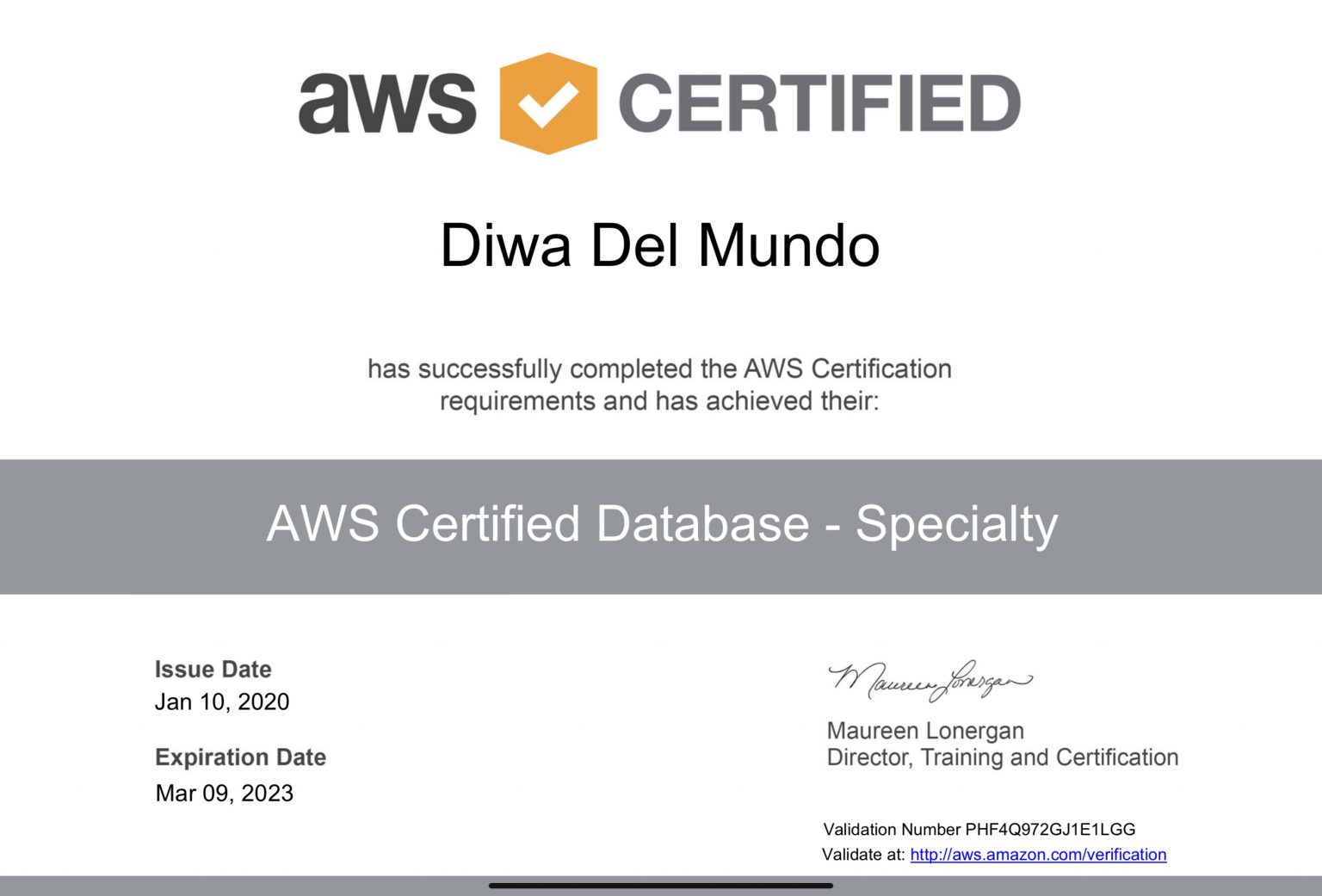The results are out for the beta exam (DB1-C01) of the AWS Certified Database – Specialty, and I’m happy to share that I passed and gained the credential.
The beta exam was difficult. To give you an idea of the difficulty level of the exam, the AWS Certified Database – Specialty is a cross between the Solutions Architect – Professional, SysOps Administrator – Associate, and Security – Specialty except that it is focused on AWS database services.
I relied heavily on the exam guide to determine focus areas. Since it is a beta exam, figuring out the exam coverage is critical. AWS is advocating “purpose-built” databases, which provides a paradigm shift on how architects and developers should look at modern data stores. Here is a good article that discusses purpose-built databases: https://aws.amazon.com/blogs/database/building-a-modern-application-with-purpose-built-aws-databases/
From the article: “The days of one-size-fits-all, monolithic databases are behind us. As Werner Vogels, CTO and VP of Amazon.com, said: “Seldom can one database fit the needs of multiple distinct use cases.” In the past, web applications were constructed by using the LAMP stack (Linux, Apache, MySQL, and PHP), where a single database was used for many different experiences.
Based on the article, it provided me a north-star for exam preparation. I booked the exam on the last day of the beta period, but I only started preparation during the last week of December 2019.
I focused my efforts heavily on the following:
- Amazon Aurora
- AWS Database Migration Service (DMS) and AWS Schema Conversation Tool (SCT)
- Amazon Redshift
- Amazon DynamoDB and DynamoDB
- Accelerator
On top of these services, I also spent much time on understanding the use cases of the other purpose-built database services:
- Amazon Neptune (Graph)
- Amazon QLDB (Ledger)
- Amazon DocumentDB (Document database with MongoDB compatibility)
- Amazon Timestream
I was lucky I have some experience with Amazon Neptune and QLDB. I spent time evaluating QLDB in its preview release, so I have a good idea of its use cases and limitations.
Exam Domains
The exam has five domains. I didn’t focus too much on Domains 4 and 5 for my preparation since I have good experience already for managing, monitoring, and securing AWS workloads. I also have the AWS Certified Security – Specialty and AWS Certified DevOps Engineer – Professional, so I have a hunch that the questions would be similar to those two certification exams.

I compiled a list of the whitepapers I used for my preparation:
- Migrating Applications Running Relational Databases to AWS Best Practices Guide
- Modernizing the Amazon Database Infrastructure Migrating from Oracle to AWS
- Database Caching Strategies Using Redis
- Amazon RDS for Aurora Export/Import Performance Best Practices
- Amazon Aurora Migration Handbook
As a Specialty exam, I expected that it requires a deep dive into the database services advanced features. I wasn’t disappointed, and that’s what exactly appeared on the exam. If you are preparing for the exam, you must read the product pages, and the developer guides multiple times end-to-end.
I’ll be writing separate articles for each domain to discuss exam preparation details. I hope this article gave you a better idea of what entails to be an AWS database specialist. AWS did a phenomenal job of developing these purpose-built databases, and it is an excellent opportunity to leverage them in building high-performance applications and platforms in the cloud.
Congratulations to those who passed the AWS Certified Database – Specialty!

The results are out for the beta exam (DB1-C01) of the AWS Certified Database – Specialty, and I’m happy to share that I passed and gained the credential.

The beta exam is difficult. To give you an idea of the difficulty level of the exam, the AWS Certified Database – Specialty is a cross between the Solutions Architect – Professional, SysOps Administrator – Associate, and Security – Specialty except that it is focused on AWS database services.
I relied heavily on the exam guide to determine focus areas. Since it is a beta exam, figuring out the exam coverage is critical. AWS is advocating “purpose-built” databases, which provides a paradigm shift on how architects and developers should look at modern data stores. Here is a good article that discusses purpose-built databases:
From the article: “The days of one-size-fits-all, monolithic databases are behind us. As Werner Vogels, CTO and VP of Amazon.com, said: “Seldom can one database fit the needs of multiple distinct use cases.” In the past, web applications were constructed by using the LAMP stack (Linux, Apache, MySQL, and PHP), where a single database was used for many different experiences. “
Based on the article, it provided me a north-star for exam preparation. I booked the exam on the last day of the beta period, but I only started preparation during the last week of December 2019.
I focused my efforts heavily on the following:
AWS Database Migration Service (DMS) and AWS Schema Conversation Tool (SCT)
Amazon DynamoDB and DynamoDB Accelerator
On top of these services, I also spent much time on understanding the use cases of the other purpose-built database services.
Amazon DocumentDB (Document database with MongoDB compatibility)
I was lucky I have some experience with Amazon Neptune and QLDB. I spent time evaluating QLDB in its preview release, so I have a good idea of its use cases and limitations.
The exam has five domains. I didn’t focus too much on Domains 4 and 5 for my preparation since I have good experience already for managing, monitoring, and securing AWS workloads. I also have the AWS Certified Security – Specialty and AWS Certified DevOps Engineer – Professional, so I have a hunch that the questions would be similar to those two certification exams.

I compiled a list of the whitepapers I used for my preparation:
Migrating Applications Running Relational Databases to AWS Best Practices Guide
Modernizing the Amazon Database Infrastructure Migrating from Oracle to AWS
Database Caching Strategies Using Redis
Amazon RDS for Aurora Export/Import Performance Best Practices
Amazon Aurora Migration Handbook
As a Specialty exam, I expected that it requires a deep dive into the database services advanced features. I wasn’t disappointed, and that’s what exactly appeared on the exam. If you are preparing for the exam, you must read the product pages, and the developer guides multiple times end-to-end.
I’ll be writing separate articles for each domain to discuss exam preparation details. I hope this article gave you a better idea of what entails to be an AWS database specialist. AWS did a phenomenal job of developing these purpose-built databases, and it is an excellent opportunity to leverage them in building high-performance applications and platforms in the cloud.

Congratulations to those who passed the AWS Certified Database – Specialty!

Diwa del Mundo
Principal Cloud Architect
Diwa holds nine AWS certifications (Solutions Architect - Professional, DevOps Engineer - Professional, Security - Specialty, and the three Associate certifications). Aside from his professional interest in AWS, Diwa is also active in the community as an AWS User Group Philippines Cloud Community Leader - Core. He is an experienced IT professional with more than ten years of experience. He is passionate in helping individuals and organizations get into the cloud.

